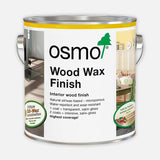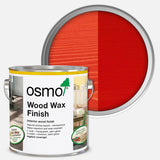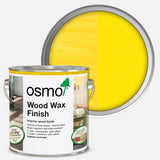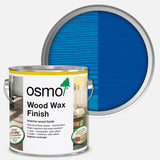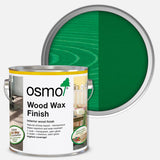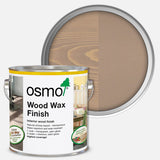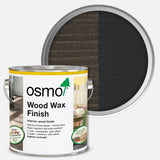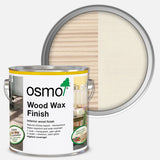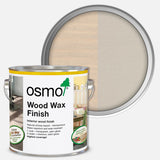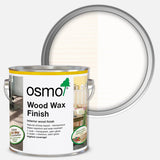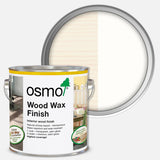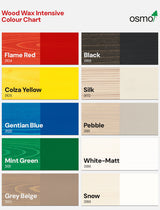Can I use Osmo finishes on top of other finishes?
For the best results, we recommend applying Osmo finishes onto a clean, dry, and raw wood surface (moisture content max. 20%). If a different stain has been previously used, gently sand any old microporous finishes such as oils or waxes. However, if varnish or lacquers have been used, they must be fully sanded, as these types of finishes can block the penetration of the Osmo finishes. Before application, ensure that you thoroughly remove any dust from the surface.
How many coats do I need to apply to protect my wood?
For all Osmo finishes we recommend a maximum of two coats. For staining wooden flooring, only one coat of colour is required followed by a final coat of Osmo Polyx Oil clear. For use in Bathrooms or Kitchens, we recommend a base coat of Osmo Wood Protector, followed by two finishing coats such as Osmo Polyx Oil. For the inside of cabinets or wardrobes, we only recommend one coat of Osmo Polyx Oil. For treating softwoods externally, we recommend a base coat of Osmo WR Base Coat, followed by two finishing coats such as UV Protection Oil.
Can I use Osmo finishes on veneered wood?
Osmo Oil finishes have been tested extensively on veneered surfaces without any problems, and we do recommend their use. We advise conducting a trial application on a small piece of timber prior to full application.
What is the drying and curing time?
As long as the wood surface is clean, dry (frost-free) and the moisture content is no more than 20% (Osmo finishes are not suitable for Green Oak), applied thinly, evenly and thoroughly onto a smooth surface - the drying time for Osmo finishes is approximately 8-10 hours. The only exceptions are Osmo Polyx Oil Rapid (approx. 4-6 hours) and Osmo Polyx Oil 2K (dries and cures within 4 hours).
Can I speed up the drying time?
Osmo finishes need to be able to dry naturally by oxidation. Opening the windows and doors to provide additional ventilation will help the airflow required. Lower temperatures can extend the drying times while higher temperatures can speed up the drying time, however we do not recommend doing this because it is likely that the finish will dry on top of the wood surface rather than naturally penetrating into the wood.
How do I apply the finish?
For our general range of products such as Osmo Polyx Oil or Osmo UV Protection Oil - apply thinly and evenly along the wood grain with either an Osmo Natural Bristle Brush or the Osmo Microfibre Roller, and spread well. Allow for good ventilation whilst drying. Once dry, apply a second coat as before. For the renovation of Osmo finishes, generally only one coat is required.
Do I need to sand between coats?
You should always assess the surface before applying the second coat, as light sanding between coats may be necessary.
Can I spray apply any of your Osmo products?
We do not recommend spraying any of our manual application products such as Osmo Polyx Oil.
Can I apply any more than two coats?
We do not recommend applying any more than the necessary two coats. Wood is porous and the Osmo products are designed to penetrate into these pores. A maximum of two coats is recommended and a third or any further coats will likely fail to penetrate, causing extended drying times and/or tacky surfaces. This can also cause the surface to scratch easily.
Are the Osmo finishes compatible with silicone sealants?
Sealants such as silicone or mastic form a non-porous surface. Osmo finishes are only able to penetrate into porous surfaces. We recommend application of a suitable Osmo finish prior to applying any sealants.
Why does the wood look patchy after applying your finish?
Different parts of each wood will absorb the finish at different rates. If you have applied just one coat, a second coat will even out the finish to provide an even and smooth finish. The wood should look and feel like wood. If the wood still looks patchy after the second coat then it may be that an existing finish is blocking the penetration in some areas more than others. Our surface preparation is recommended that the wood is clean, dry and raw prior to application. We do not recommend cleaning the surface with any acids (especially oxalic acid) as these can also react with the tannings in the wood, causing patches.
Why has the finish not dried?
Extended drying times occur when the finish penetrates the wood slowly, which can be caused by several factors. The most common cause is over-application. If there is an excessive amount of finish on the surface, there will be no space for the finish to penetrate the wood, creating a tacky or sticky surface. To rectify this, open windows and doors to improve ventilation, allowing the finish to dry naturally by oxidation. Another cause of extended drying times could be an old or existing finish blocking or slowing the penetration.
Rest assured that the finish will eventually dry, although some timber species, may take several weeks to dry under the mentioned scenarios. To rectify over-application, remove the excess with a cloth and white spirit to help the penetration. If this does not work, sanding and re-application may be necessary.
How long will the finish last?
The renovation period for Osmo exterior products typically depends on the elements and can vary from six months to five years. Generally, we recommend renovation every 3-5 years, except for timber that faces north, west, or is located by the coast. In such cases, we recommend annual renovation.
Renovation is very easy. Simply re-apply one thin coat (of the product you used originally) onto a clean, dry surface.
What happens if I damage part of my floor?
Unlike traditional lacquers, Osmo Oil products allow damaged areas on floors to be sanded and re-treated without any visible brush marks. To repair damage, simply re-apply Osmo Polyx-Oil after sanding the affected area only. To start, cordon off the damaged area using masking tape, then evenly sand the cordoned surface. Next, apply a thin coat of Osmo Polyx Oil evenly to the surface using a microfibre roller. Allow it to dry before applying a second thin coat. Due to sanding the damaged area, the natural lighter colour of the wood may become visible. However, this difference will balance out over time.
Can I enhance the sheen on my satin finish?
The sheen-level for a wood surface treated with Osmo Polyx Oil can be enhanced with Osmo Liquid Wax Cleaner.
I have applied a satin finish and now I would like a matt finish, is this possible?
Yes, you can apply Osmo Polyx Oil Matt over the Osmo Polyx Oil Satin and vice versa. However, if you have recently applied Satin and you have completed the maximum of two coats, then we recommend cleaning or fine sanding the surface to allow an extra coat of Matt or vice versa.
You don't have the colour I'm looking for, can I mix colours?
Osmo has a wide range of colours available for interior and exterior use. Internally, if the colour you are looking for is not within the Osmo Polyx Oil Tints, Osmo Wood Wax Finish Transparent or Osmo Wood Wax Finish Creativ ranges - you can mix any of these colours together to any mixed ratio, including the Osmo Polyx Oil clear - to achieve any effect possible.
Where are Osmo products made and how?
The principal office is located in Warendorf and the production takes place in Warendorf and Münster, Germany. Osmo products are distributed by more than 2500 specialist dealers in Germany in numerous countries all over the world. The foundation of Osmo wood finishes has been based upon purified and refined natural resources throughout the last 30 years. The dry finish fulfils both the DIN EN 71.3 (suitable for children's toys) and DIN 53160 (fast to perspiration and saliva) and as such is safe for humans, animals and plants. Osmo uses carefully harvested natural oils (sunflower, soya, linseed and thistle oil) and hard waxes (carnauba and candellila wax) for its finishes.
Are Osmo products certified?
Osmo products are in accordance with, and certified to, relevant VOC-regulations as per DIN EN ISO 9001:2000 (Quality management systems) and 14001 (environmental management systems), demonstrating that Osmo, as a responsible manufacturer of wood and wood finishes, is committed to developing itself and it's products to meet both the ecological and economic challenges which are faced in modern times. Due to the low amounts of solvents used in our products, the Osmo production facility has not been bound by the German emissions law since 1998, in addition to these technical systems are also encapsulated to ensure that very little emissions can enter the atmosphere.
Do Osmo products contain harmful substances?
Osmo products are produced on a base of carefully refined plant oils and waxes. The surface is safe for humans, animals and plants when dry (suitable for children's toys acc. to EN 71.3).
To give you the best rate, we offer various delivery options based on your destination, product type and order size. View our rates below or proceed to checkout to calculate your delivery cost.
Free Pickup - Somerton VIC
Free pickup available between 7.00am - 3.00pm Monday to Friday, excluding public holidays.
Trade Local Delivery - Forklift Required
Flat-rate delivery for local trade customers. All trade deliveries require a forklift for safe unloading. Estimated 1 business day (excluding factory lead time).
| Within 50 km of Somerton VIC | $50 flat rate |
| 50-100 km from Somerton VIC | $75 flat rate |
Panel Products
Panel product delivery rates scale with weight and distance to give you the best possible price across Australia. Estimated 2-3 business days (excluding factory lead time).
Please review our Panel Product Delivery Safety Guidelines before ordering.
| Total Order Weight (kg) | VIC | NSW | ACT | SA | QLD | NT | WA | TAS |
|---|---|---|---|---|---|---|---|---|
| Up to 49 kg | $70 | $95 | $95 | $100 | $110 | $135 | $135 | $135 |
| 50 - 149 kg | $120 | $165 | $165 | $180 | $190 | $230 | $230 | $230 |
| 150 - 249 kg | $140 | $250 | $250 | $280 | $300 | $370 | $370 | $370 |
| 250+ kg | $150 | $470 | $470 | $495 | $510 | $600 | $600 | $600 |
Lightweight Items
Flat-rate shipping Australia-wide. Estimated 2-8 business days (excluding factory lead time).
| Edge Banding, Timber Oils and Pre-Glued Veneer Leaves | $40 flat rate Australia-wide |
| Paper Back Veneers, 1mm Laminates and Liners (excl. Magnetic Laminate) | $70 flat rate Australia-wide |
Samples
Affordable sample shipping with free standard post in Victoria.
| Local Delivery VIC | FREE Standard Post (2-8 business days) |
| $15 Express Post (1-4 business days) | |
| Rest of Australia | $15 Standard Post (2-8 business days) |
- Polyx®-Oil 3032/3062 Product Information Download
- Polyx®-Oil Tints 3073/3075 Product Information Download
- Wood Wax 3169/3188 Product Information Download
- Polyx®-Oil 3032/3062 Material Safety Data Sheet Download
- Polyx®-Oil Raw 3044 Material Safety Data Sheet Download
- Polyx®-Oil Tints 3073/3075 Material Safety Data Sheet Download
- Wood Wax 3169/3188 Material Safety Data Sheet Download
- Osmo Oil vs Polyurethane Download













